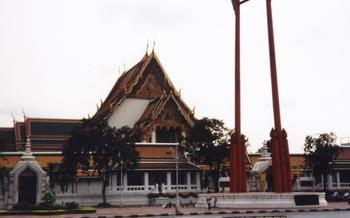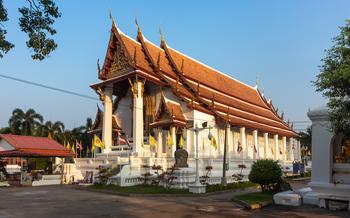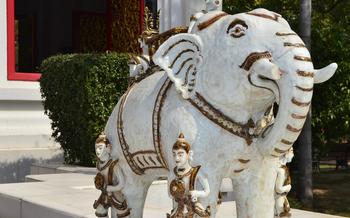
Chang Phueak Shrine
- Historical Significance
- Religious Significance
- Cultural Importance
- Architectural Beauty
- Local Festivals and Ceremonies
- Pilgrimage and Tourism
- Role of Monks and Religious Figures
- Local Arts and Crafts
- Legends and Stories
- Community Involvement
- Social and Cultural Significance
- Photography and Videography
- Respect and Etiquette
Historical Significance
The Chang Phueak Shrine holds immense historical significance for the people of Narathiwat, having been constructed in the 19th century as a place of worship for the local Buddhist community. It is said to have been built on the site of an ancient Khmer temple, which adds to its allure and mystique. The shrine's architectural style is a blend of traditional Thai and Khmer elements, reflecting the region's rich cultural heritage. Over the years, the shrine has undergone several renovations and expansions, but its original charm and sacredness have been meticulously preserved. It remains a vibrant center of religious devotion and a symbol of the community's deep-rooted Buddhist traditions.
Religious Significance
The Chang Phueak Shrine holds immense religious significance for Buddhist pilgrims and devotees from Narathiwat and beyond. It is believed to be a sacred site where the spirit of a revered monk, known as Luang Phor Chang Phueak, resides. Devotees flock to the shrine to pay their respects, seek blessings, and pray for good fortune and protection.
The shrine's main ritual is the offering of alms to the monks who reside there. Devotees make offerings of food, flowers, and other items as a way of showing their gratitude and seeking merit. They also light candles and incense sticks, and chant prayers to invoke the blessings of Luang Phor Chang Phueak and other deities.
Monks play a crucial role in maintaining the shrine and its religious traditions. They lead daily prayers and meditation sessions, and provide guidance and support to devotees. They also conduct special ceremonies and rituals throughout the year, such as the annual Kathin ceremony, which marks the end of the Buddhist Lent period.
During these ceremonies, the shrine is adorned with colorful decorations and offerings, and devotees gather to participate in chanting, meditation, and other religious practices. The atmosphere is filled with a sense of devotion, serenity, and spiritual connection.
Cultural Importance
The Chang Phueak Shrine serves as a hub for preserving and promoting local culture and traditions. It acts as a gathering place for the community, fostering social interaction and a deep sense of belonging. The shrine's involvement in local arts and crafts, such as the creation of amulets and religious artifacts, further contributes to its cultural significance. These sacred objects hold deep meaning for devotees and serve as tangible representations of the community's beliefs and practices.
Stories abound of individuals whose lives have been touched and influenced by the shrine. Locals often recount tales of miraculous interventions, answered prayers, and spiritual awakenings experienced within its sacred walls. These personal narratives underscore the profound impact the shrine has had on the lives of countless individuals, strengthening their faith and enriching their cultural identity.
Architectural Beauty
The Chang Phueak Shrine stands out for its unique architectural style, which blends Lanna and Thai influences. The main shrine building features a distinctive stepped roof with intricate carvings and colorful ceramic tiles. The roof's graceful curves and multiple tiers create a sense of height and grandeur, drawing the eye upward.
The shrine's exterior is adorned with intricate carvings and sculptures depicting mythical creatures, deities, and scenes from Buddhist mythology. These carvings showcase the skill and artistry of local craftsmen and reflect the rich cultural heritage of Narathiwat. The use of vibrant colors, such as gold, red, and green, adds to the shrine's vibrant and captivating appearance.
The shrine's interior is equally impressive, with a spacious main hall that houses the principal Buddha image. The hall's high ceilings and open layout create a sense of serenity and tranquility, conducive to meditation and prayer. The walls are adorned with murals depicting the life of Buddha and other important Buddhist stories, adding to the shrine's spiritual significance.
Local Festivals and Ceremonies
The Chang Phueak Shrine is a vibrant and dynamic center for local festivals and ceremonies throughout the year. These events draw thousands of devotees and visitors from near and far, who come to celebrate the shrine's religious significance and experience the rich cultural traditions of Narathiwat.
One of the most important festivals is the annual Songkran festival, which takes place in April and marks the Thai New Year. During Songkran, the shrine is adorned with colorful decorations, and devotees participate in water-blessing ceremonies and merit-making rituals. The festival is a time for families and friends to come together, celebrate the new year, and seek blessings for the year ahead.
Another significant festival is the Kathin ceremony, which is held in October or November. During Kathin, devotees offer new robes to the monks who reside at the shrine, as a symbol of gratitude and support. The ceremony is accompanied by chanting, processions, and other rituals, and it is a time for the community to come together and celebrate the generosity and compassion of the Buddhist faith.
In addition to these major festivals, the Chang Phueak Shrine also hosts a variety of smaller ceremonies and events throughout the year. These include daily prayers and meditation sessions, as well as special ceremonies to mark important Buddhist holidays and observances. Visitors are welcome to attend these events and experience the vibrant spiritual and cultural traditions of the shrine.
Pilgrimage and Tourism
The Chang Phueak Shrine is a popular pilgrimage site for Buddhist devotees from Thailand and beyond. Pilgrims come from all walks of life to pay their respects, make offerings, and seek blessings from the sacred Buddha image enshrined within the shrine.
During major festivals and ceremonies, the shrine attracts thousands of pilgrims who participate in various religious rituals and activities. These events provide an opportunity for devotees to connect with their faith, receive spiritual guidance from monks and religious teachers, and share their experiences with fellow pilgrims.
In addition to its religious significance, the shrine also plays an important role in the local economy. Tourism generated by pilgrims and other visitors brings much-needed revenue to the community. Many local businesses, such as restaurants, hotels, and souvenir shops, rely on the shrine for their livelihood.
For pilgrims and tourists alike, a visit to the Chang Phueak Shrine is a truly enriching experience. It is an opportunity to immerse oneself in the vibrant culture and traditions of Narathiwat, to learn about the history and significance of the shrine, and to connect with the local community.
Role of Monks and Religious Figures
The Chang Phueak Shrine is under the care and management of a dedicated group of monks and religious figures who play a vital role in preserving and upholding its sacred traditions. These monks reside at the shrine and dedicate their lives to prayer, meditation, and community service. They are responsible for conducting daily rituals and ceremonies, such as morning and evening prayers, chanting sutras, and making offerings to the Buddha.
Monks at the shrine also serve as spiritual guides and teachers to the local community. They provide religious instruction, offer blessings, and counsel those in need. Their presence at the shrine creates a sense of peace and tranquility, and they are highly respected and revered by the local people.
One of the most important roles of the monks is to maintain the shrine's physical structure and grounds. They ensure that the shrine is kept clean and well-maintained, and they oversee any renovations or repairs that may be necessary. They also work to preserve the shrine's cultural heritage by collecting and documenting its history, legends, and traditions.
The monks and religious figures at the Chang Phueak Shrine are dedicated to preserving the shrine's religious significance and ensuring that it remains a place of worship, pilgrimage, and community gathering for generations to come.
Local Arts and Crafts
The Chang Phueak Shrine is renowned for its vibrant and intricate arts and crafts, which are deeply rooted in the local culture and traditions. Artisans in the surrounding community create a variety of sacred objects, including amulets, religious statues, and intricate decorative items, that are sold at the shrine and in nearby shops.
Amulets, known locally as "Phra Kring," are particularly popular among devotees. These small, often elaborately designed pendants are believed to bring good luck, protection, and blessings to their wearers. Artisans use a variety of materials to create amulets, including gold, silver, bronze, and sacred metals.
In addition to amulets, visitors can find a wide range of religious statues and decorative items at the shrine. These include Buddha images, representations of Hindu deities, and various mythical creatures. Many of these items are handcrafted using traditional techniques and materials, ensuring their uniqueness and authenticity.
Purchasing these handmade items not only supports local artisans but also helps preserve and promote the traditional crafts and skills that are an integral part of Narathiwat's cultural heritage. Visitors are encouraged to explore the stalls around the shrine and take home a piece of this rich artistic tradition as a meaningful souvenir or gift.
Legends and Stories
The Chang Phueak Shrine is steeped in legends and stories that have been passed down through generations, adding to its mystique and allure. One popular legend tells of a revered monk named Luang Pu Thuat, who is believed to have visited the shrine and blessed it with his presence. It is said that Luang Pu Thuat left an imprint of his hand on one of the shrine's pillars, which remains visible to this day and is considered a sacred relic.
Another legend associated with the shrine revolves around a mythical creature known as the naga, a large serpent-like deity often depicted in Thai mythology. According to legend, a naga once resided in the nearby river and would often visit the shrine to pay homage to the Buddha image. The naga is said to have protected the shrine from harm and brought good fortune to the local community.
These legends and stories have played a crucial role in shaping the shrine's reputation as a sacred and auspicious place. They have also contributed to the shrine's popularity among pilgrims and tourists, who come to experience the shrine's spiritual atmosphere and to learn more about its rich history and traditions.
Community Involvement
The Chang Phueak Shrine serves as a central gathering place for the local Narathiwat community, fostering a deep sense of belonging and unity among its residents. Its role extends beyond religious practices, as it actively promotes social interaction, cultural preservation, and community initiatives. The shrine organizes various events throughout the year, such as merit-making ceremonies, traditional Thai dance performances, and educational workshops, which bring people together to celebrate their shared heritage and strengthen their bonds.
By participating in these events, community members have the opportunity to connect with one another, share stories, and contribute to the overall well-being of their neighborhood. The shrine also serves as a venue for local artisans to showcase their skills and sell their handmade crafts, creating a vibrant marketplace that supports local businesses and entrepreneurs. The sense of community fostered by the shrine is palpable, and visitors often remark on the warmth and hospitality of the local people.
Social and Cultural Significance
The Chang Phueak Shrine holds immense social and cultural significance for the people of Narathiwat. It serves as a symbol of local identity and pride, embodying the unique cultural heritage of the region. The shrine's preservation and promotion contribute to the overall cultural landscape of Thailand, showcasing the diversity and richness of the country's religious traditions. Visitors to the shrine can immerse themselves in the vibrant local culture, learn about the history and beliefs of the Narathiwat people, and gain a deeper appreciation for the intricate tapestry of Thai culture. Through its enduring presence and spiritual significance, the Chang Phueak Shrine stands as a testament to the enduring power of faith and the resilience of cultural traditions in the face of change.
Photography and Videography
The Chang Phueak Shrine is a photographer's paradise, with its intricate architecture, vibrant colors, and serene atmosphere. Visitors are encouraged to capture their memories through photography or videography, but there are a few things to keep in mind.
First, be respectful of the shrine's sacred nature. Avoid using flash photography or tripods, and be mindful of your surroundings to ensure you're not blocking the way for other visitors or disrupting any religious ceremonies.
Second, take advantage of the shrine's natural beauty. The best time to photograph the shrine is during the early morning or late afternoon, when the sunlight casts a warm glow on the buildings and statues.
Finally, don't be afraid to experiment with different angles and perspectives. The shrine's many nooks and crannies offer endless opportunities for creative shots.
Whether you're a professional photographer or simply a casual traveler, the Chang Phueak Shrine is sure to provide you with plenty of photo and video opportunities.
Respect and Etiquette
When visiting the Chang Phueak Shrine, it is essential to be mindful of local customs and traditions to show respect for the sacred nature of the site. Before entering the shrine, remove your shoes and leave them neatly arranged outside. Upon entering the shrine, wai, or bow slightly, to monks and religious figures as a sign of reverence. Maintain a quiet and composed demeanor while inside the shrine, avoiding loud conversations or disruptive behavior. Remember that the shrine is a place of worship and contemplation, and it is important to respect the tranquility of the environment. Refrain from touching or climbing on any statues or religious objects, as these are considered sacred and should be treated with utmost respect. By observing these customs and behaving respectfully, visitors can contribute to the preservation of the shrine's sacred atmosphere and ensure a meaningful and enriching experience for all.




